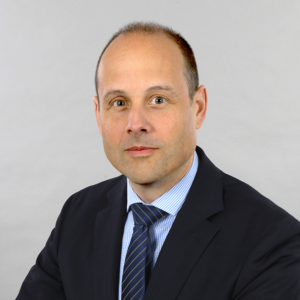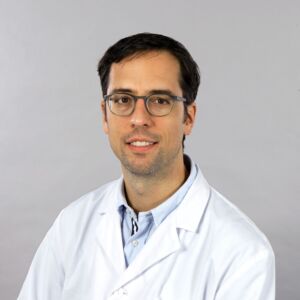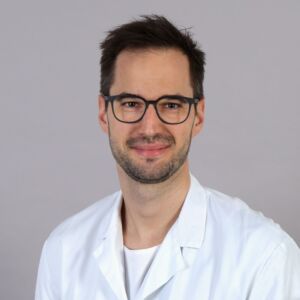The most common surgical therapies are operations for a defect in the eardrum, removal of a cholesteatoma, and hearing-improving operations on the auditory ossicles (in particular stapedotomy for otosclerosis). In addition, implantable hearing systems including cochlear implants are used, or benign tumors of the auditory nerve (vestibular schwannomas) are surgically removed. The external appearance of the auricle can also be surgically corrected.
Hearing-improving operations (ossiculoplasty)
Repeated inflammation of the ear, chronic ear inflammation or trauma to the skull bone can lead to destruction or damage to the ossicles (malleus, incus, stapes) in the middle ear. As a result, the vibrations of the eardrum can no longer be conducted efficiently into the inner ear, resulting in conductive hearing loss. In this situation, the ossicles can be reconstructed. Depending on the situation, we have various prostheses available.
Surgical treatment of otosclerosis (stapedotomy)
Otosclerosis is a disease of the middle and inner ear. It affects the bone around the cochlea and the organ of balance and leads to bone remodeling. If this bone remodeling affects the ossicles, they become fixed and vibrations can no longer be transmitted efficiently to the inner ear. Of the ossicles, the stapes is most frequently affected. In some cases, the cochlea is also affected. This can then lead to destruction of the inner ear structures, resulting in sensorineural hearing loss.
If the auditory ossicles are affected, there is the option of surgical treatment as an alternative to hearing aid fitting. During this operation (stapedotomy), an artificial stapes made of titanium and Nitinol is inserted. This prosthesis is fixed to the anvil with the laser and protrudes directly into the inner ear fluid through an opening measuring 0.7 mm.
Surgical closure of an eardrum perforation
A hole in the eardrum can be caused by an accident or an inflammation. After an accident (blow to the ear, fall, manipulation such as accidental injury with a cotton bud, diving accident) the perforation often closes again spontaneously (without therapy).
After a severe middle ear infection, the eardrum can rupture. Fluid then flows out of the ear and the pain subsides. The hole can also close again spontaneously after an inflammation. Occasionally, however, it persists.
This perforation often causes no symptoms. However, the hole can cause sounds to be transmitted to the inner ear at a reduced level, which is perceived as hearing loss. There is also a risk of infection after contact with water. Various surgical techniques are available to close a hole in the eardrum.
Treatment of chronic ear inflammation (cholesteatoma)
Cholesteatoma is a chronic inflammation of the middle ear in which skin (squamous epithelium) grows into the middle ear. This may be due to chronic negative pressure in the middle ear, or skin cells may enter the middle ear through trauma to the eardrum. Congenital skin can also be located behind the intact eardrum and grow.
This chronic inflammation of the ear is not always noticed. It usually manifests itself as hearing loss and repeated discharge of secretions from the ear. Although cholesteatoma is not a malignant disease, it can destroy the bony structures in the ear. Surgical removal is therefore necessary.
Hearing implants
For certain patients, hearing aid fitting is not possible. For example, in the case of ear atresia, if the ear or the auditory canal is not aligned, or if recurring infections make it impossible to wear conventional hearing aids. For these patients, an active middle ear implant or bone conduction hearing aids are an alternative.
Active middle ear implants (Soundbridge) mechanically stimulate the ossicles or the membrane of the round window bordering the inner ear directly. These systems are partial implants. They consist of an externally mounted voice processor with microphone and battery/battery. The acoustic signals are converted into an electrical signal and sent to the implant via the intact skin. There they reach the vibrating stimulator, which is attached to the auditory ossicles or the round window.
Bone conduction hearing aids cause the skull to vibrate. These vibrations then reach the inner ear via the bone and stimulate it directly. There are various bone conduction hearing aids, which are coupled to the bone or skin in different ways depending on the model.
Ventilation disorder of the middle ear
The Eustachian tube is the connection between the middle ear and the nasopharynx. It serves to adjust the pressure of the middle ear to the ambient pressure. A functional disorder can be manifested by fluid accumulation in the middle ear with hearing loss, or by pain in the ear when rapidly coping with a difference in altitude (landing in an airplane).
To improve function, the first measure that can be tried is to reduce swelling of the nasal mucosa with anti-inflammatory sprays. In the absence of success, tube dilatation is available. Under anesthesia, a small balloon is inserted into the Eustachian tube via the nose and the Eustachian tube is dilated by inflating the balloon. Alternatively, a tube can be inserted into the eardrum.


